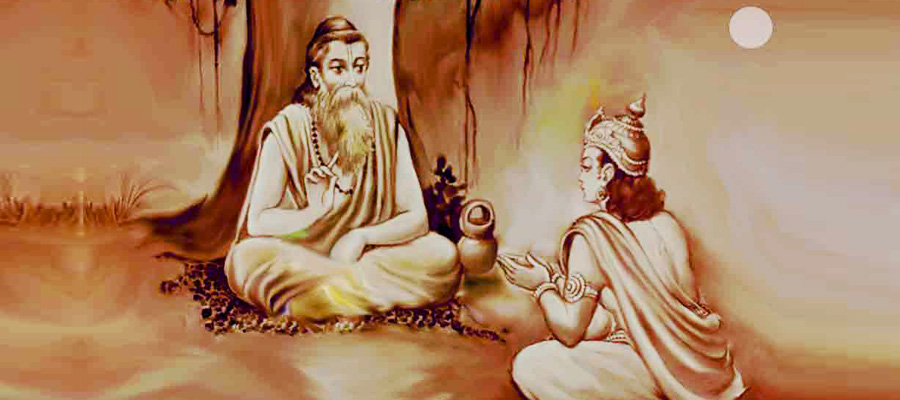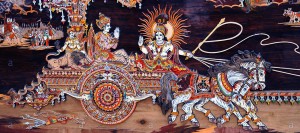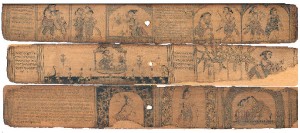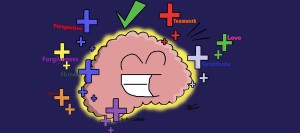The Self
One of the most widely discussed topics throughout both the early and late Upaniṣads is the self (ātman). The word “ātman” is a reflexive pronoun, likely derived from √an (to breathe). Even in the Ṛgveda (c.1200 B.C.E.), the earliest textual source from ancient India, ātman had already a wide range of lexical meanings, including ‘breath’, ‘spirit’, and ‘body’. By the time of the Upaniṣads, the word was used in a variety of ways, sometimes referring to the material body, but often designating something like an essence, a life-force, consciousness, or ultimate reality.
One of the most well-known teachings of ātman appears in the Chāndogya Upaniṣad (6.1-16), as the instruction of the brahmin Uddālaka Āruṇi to his son Śvetaketu. Uddālaka begins by explaining that one can know the universal of a material substance from a particular object made of that substance: by means of something made of clay, one can know clay; by means of an ornament made of copper, one can know copper; by means of a nail cutter made of iron, one can know iron. Uddālaka uses these examples to explain that objects are created from nothing, but rather that creation is a process of transformation from an original being (sat) which emerges into the multiplicity of forms that characterizes our everyday experiences. Uddālaka’s explanation of creation is often assumed to have influenced the satkāryavāda theory—the theory that the effect exists within the cause—which was accepted by the Sāṃkhya, Yoga, and Vedānta darśanas.
Later in his instruction to Śvetaketu, Uddālaka makes a series of inferences from comparisons with empirically observable natural phenomena to explain that the self is a non-material essence present in all living beings. He first uses the example of nectar, collected by bees from different sources, but when gathered together becomes an undifferentiated whole. Similarly, water flowing from different rivers merges together without distinction when reaching the ocean. Uddālaka then asks Śvetaketu to conduct two simple experiments. In the first, he instructs his son to cut a banyan fruit, and then the seed within the fruit, only for his son to find that he cannot observe anything inside the seed. Uddālaka compares the fine essence of the seed, which cannot even be seen, to the self. Uddālaka then tells Śvetaketu to place some salt in water. When returning the next day, Śvetaketu cannot see the salt anywhere in the water, but by tasting the water he perceives that it is equally distributed throughout. Uddālaka concludes that, like salt in water, the self is not immediately discernible, but yet permeates the entire body. After each of these comparisons with natural phenomena, Uddālaka brings attention back to Śvetaketu, emphasizing that the self operates the same way in him as it does in all living beings. Repeating the phrase ‘you are that’ (tat tvam asi) throughout his discourse, the thrust of Uddālaka’s teaching is that the self is both the essence that connects parts with the whole and the constant that remains the same even while taking on different forms. Thus, he offers an organic understanding of ātman, characterizing the self in terms of the life force that animates all living beings.
Yājñavalkya, the most prominent teacher in the Bṛhadāraṇyaka Upaniṣad, characterizes ātman more in terms of consciousness than as a life-giving essence. In a debate that pits him against Uddālaka—his senior colleague and, by some accounts, his former teacher (BU 6.3.7; 6.5.3)—Yājñavalkya explains that the self is the inner controller (antaryāmin), present within all sensing and cognizing, yet at the same time distinct (BU 3.7.23). Here, Yājñavalkya characterizes the self as that which has mastery over the otherwise distinct psycho-physical capacities. He goes on to explain that we know the existence of the self through actions of the self, through what the self does, not through our senses—that the self, as consciousness, cannot be an object of consciousness.
Another recurring theme in Yājñavalkya’s discussion with Janaka is that the self is described as consisting of various parts, but not reducible to any (e.g BU 4.4.5; see also TU 2.2.1). Similarly, in a creation myth at the beginning of the Āitareya Upaniṣad, ātman is cast as a creator god, who creates the various elements and bodily functions from himself (ĀU 1.3.11). As with Yājñavalkya’s teaching, in this passage, the functions of the body and cognitive capacities are seen to be components of the self and even evidence of the self, but the self cannot be reduced to any particular part. Such examples emphasize that an understanding of the self cannot be attained through observing how the self operates in just one faculty, but by means of observing the self in relation to a number of psycho-physical faculties, and their relationship with each other. In addition to being portrayed as the agent or inner controller (antaryāmin) of sensing and cognizing, the self is characterized as an underlying base or foundation (pratiṣṭha) of all the sense and cognitive faculties. Throughout his teachings Yājñavalkya describes the self as being hidden or behind that which is immediately perceptible, suggesting that the self cannot be known by rational thought or described in conventional language because it can never be the object of thought or knowledge. Here, Yājñavalkya draws attention to the limitations of language, suggesting that because the self cannot be an object of knowledge it cannot have attributes, and therefore can only be described by using negative propositions.
Another prominent teacher of the self is Prajāpati, the creator god of Vedic ritual texts, who is recast in the Chāndogya Upaniṣad as a typically aloof guru, who is reluctant to disseminate his teachings (CU 8.7-12). Similar to Yājñavalkya, Prajāpati conceptualizes the self in terms of consciousness, describing ātman as the agent responsible for sensing and cognizing: ātman is ‘the one who is aware’ (CU 8.12.4-5). However, despite some similarities with Yājñavalkya’s teaching of ātman, Prajāpati seems to reject some of his positions. Prajāpati’s teaching is presented in the context of his instruction to the god Indra, taking place during several episodes over a period of more than one hundred years. In his first teaching, Prajāpati defines the self as the material body and sends Indra away thinking he has learned the true teaching. Before going back to the other gods, however, Indra realizes that this teaching cannot be true, and returns to Prajāpati to learn more. This pattern continues several times before Prajāpati finally presents ātman as the ‘one who is aware’ of his final and true teaching. One of the teachings that Prajāpati presents as false, or at least as incomplete, is a description of ātman in terms of dreamless sleep, a teaching of the self that Yājñavalkya describes as the ‘highest goal’ and ‘the highest bliss’ in his instruction to King Janaka in the Bṛhadāraṇyaka Upaniṣad (4.3.32).
Despite the diversity among these teachings, most of the discussions represent a different set of concerns than those found in earlier Vedic texts, with many teachings focusing on the human body and individual person as opposed to the primordial or ideal body, as often discussed in Vedic rituals. Rather than assuming a correspondence between the human body and the universe, some of the teachings about the self in the Upaniṣads begin to show an interest in the fundamental essence of life.
Ātman and Brahman
Perhaps the most famous teaching of the self, the identification of ātman and brahman, is delivered by Śāṇḍilya in the Chāndogya Upaniṣad. After describing ātman in various ways, Śāṇḍilya equates ātman with brahman (CU 3.14.4), implying that if one understands Brahman as the entire world, and one understands that the self is brahman, then one becomes the entire world at the time of death.
Although Śāṇḍilya’s teaching of ātman and brahman is often considered the central doctrine of the Upaniṣads, it is important to remember that this is not the only characterization either of the self or of ultimate reality. While some teachers, such as Yājñavalkya, also equate ātman with brahman (BU 4.4.5), others, such as Uddālaka Āruṇi, do not make this identification. Indeed, Uddālaka, whose famous phrase tat tvam asi is later taken by Śaṅkara to be a statement of the identity of ātman and brahman, never uses the term “brahman”—neither in his instruction to his son Śvetaketu nor on any other of his many appearances in the Upaniṣads. Moreover, it is often unclear, even in Śāṇḍilya’s teaching, whether linking ātman with brahman refers to the complete identity of the self and ultimate reality, or if ātman is considered an aspect or quality of brahman. Such debates about how to interpret the teachings of the Upaniṣads have continued throughout the Indian philosophical tradition, and are particularly characteristic of the Vedānta darśana.
Furthermore, while most teachings about brahman assume that the world emerged from one undifferentiated abstract cosmic principle, there are a number of passages explaining creation in terms of a more materialist point of view, describing the world as coming forth from an initial natural element, such as water or air. The Bṛhadāraṇyaka Upaniṣad (5.1), for example, contains teaching attributed to the son of Kauravyāyanī, depicting brahman as space. This same section of the Bṛhadāraṇyaka Upaniṣad (5.5.1) includes a passage describing the world as beginning from water. Similarly, in the Chāndogya Upaniṣad (4.3.1-2), Raikva traces the beginning of the world to wind in the cosmic sphere, and breath in the microcosm.
Returning to the self, and keeping in mind later philosophical developments, it is also worth noting that the Upaniṣads often present ātman in ways that contrast with the changeless and inactive descriptions of the self as articulated by traditions such as Sāṃkhya, Yoga, and Advaita Vedānta. As we have seen, the self can be characterized as both active and dynamic: as the inner controller (antaryāmin), the self is depicted as the agent or actor behind all sensing and cognizing faculties (for example, BU 3.7.23); while as a creator god, ātman is cast as a personal deity—closely resembling Prajāpati—from whom all creation emanates (BU 1.4.1; 1.4.17; TU 2.1; AU 1.1).
One feature of the self that is quite consistent throughout the Upaniṣads and continues to be shared by a number of subsequent of Hindu philosophy is that knowledge of ātman can lead to some sort of liberation or ultimate freedom. While the Sāṃkhya and Yoga school would conceptualize such emancipation as kaivalya—abstraction, autonomy from nature—and Advaita Vedāntins as freedom from ignorance (avidya), in the Upaniṣads the ultimate goal achieved through knowledge of the self is primarily freedom from death. Nonetheless, a prominent philosophical strand in the Upaniṣads, particularly in the teachings of Yājñavalkya, is that ātman dwells within the body when it is alive, that ātman, in one way or another, is responsible for the body being alive, and that ātman does not die when the body dies, but rather finds a dwelling place in another body. Such depictions seem to have been a catalyst for or been developed alongside early Buddhist conceptions of selfhood. The Buddhists explicitly rejected any notion of an indivisible and unchanging self, not only introducing the term “not-self” (anātman in Sanskrit; anattā in Pāli) to describe the lack of any fixed essence, but also explaining karmic continuity from one lifetime to the next in terms of the five skandhas—a theory maintaining that what Upanishadic thinkers take to be a unified self is really made of five components, all of which are subject to change.





